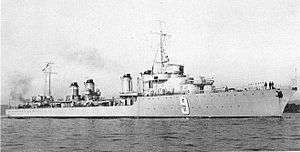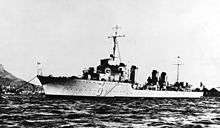Vauquelin-class destroyer
 Kersaint | |
| Class overview | |
|---|---|
| Name: | Vauquelin class |
| Operators: |
|
| Preceded by: | Aigle class |
| Succeeded by: | Le Fantasque class |
| Completed: | 6 |
| Lost: | 6 |
| General characteristics | |
| Type: | Destroyer |
| Displacement: | 2,441 long tons (2,480 t) |
| Length: | 129 m (423 ft 3 in) |
| Beam: | 11.84 m (38 ft 10 in) |
| Draught: | 4.97 m (16 ft 4 in) max |
| Propulsion: | Geared turbines, 4 boilers, 64,000 shp (47,725 kW) |
| Speed: | 36 knots (67 km/h; 41 mph) |
| Range: | 3,650 nmi (6,760 km; 4,200 mi) at 18 kn (33 km/h; 21 mph) |
| Complement: | 220 officers and men |
| Armament: |
|
The Vauquelin-class large destroyers (contre-torpilleurs) of the French Navy were laid down in 1930 and commissioned in 1931. They were very similar to the previous Aigle class, the only differences being a single extra torpedo tube and the ability to carry naval mines. The class saw action in World War II.
Ships
- (Pennant numbers: 2, 3, 93 and X92)
- Named after the 18th century naval captain Jacques Cassard
- Built by Ateliers et Chantiers de Bretagne, Nantes
- Completed 10 September 1933
- Scuttled 27 November 1942
- Broken up in situ 1956

Chevalier Paul in the mid-1930s
- (Pennant numbers: 3, 2, 53, X52)
- Named after 17th century admiral Chevalier Paul
- Built by Forges et Chantiers de la Méditerranée, La Seyne
- Completed 20 July 1934
- Torpedoed and sunk off Syrian coast 16 June 1941
- (Pennant numbers: 9, 92, X93)
- Named after Admiral Armand de Kersaint
- Built by Ateliers et Chantiers de la Loire, St Nazaire
- Completed 31 December 1933
- Scuttled 27 November 1942
- Broken up in situ 1950
- (Pennant numbers: 7, 91, X91)
- Named after French admiral Jean Armand de Maillé-Brézé,
- Built by Ateliers et Chantiers de St Nazaire-Penhoet, St Nazaire
- Completed 6 April 1933
- Lost by accidental explosion 30 April 1940, Greenock, Scotland
- Refloated and scrapped
- (Pennant numbers: 1, 51, X51)
- Named in honour of Jean-François Tartu
- Built by Ateliers et Chantiers de la Loire, St Nazaire
- Completed 31 December 1932
- Scuttled 27 November 1942
- Broken up in situ 1956
- (Pennant numbers: 8, 52, X53)
- Named after Jean Vauquelin
- Built by Ateliers et Chantiers de France, Dunkirk
- Completed 3 November 1933
- Scuttled 27 November 1942
- Broken up in situ 1951

Vauquelin (left) and Kersaint scuttled in Toulon, November 27, 1942
Maillé Brézé was lost on 30 April 1940 after a torpedo accident at Greenock, Scotland, killing 25 of her crew (sabotage was suspected at the time). Chevalier Paul was sunk off the coast of Syria on 16 June 1941 by British torpedo bombers. Vauquelin, Cassard, Kersaint and Tartu were all scuttled in Toulon Harbour on 27 November 1942 to prevent their capture by Germany; these ships were too badly damaged to be salvaged.
Notes
References
- Chesneau, Roger, ed. (1980). Conway's All the World's Fighting Ships 1922–1946. Greenwich, UK: Conway Maritime Press. ISBN 0-85177-146-7.
- Jordan, John & Moulin, Jean (2015). French Destroyers: Torpilleurs d'Escadre & Contre-Torpilleurs 1922–1956. Barnsley, UK: Seaforth Publishing. ISBN 978-1-84832-198-4.
- Saibène, Marc (n.d.). Toulon et la Marine 1942-1944. Bourg en Bresse: Marines Editions at Realisations.
- Whitley, M. J. (1988). Destroyers of World War Two. Annapolis, Maryland: Naval Institute Press. ISBN 0-87021-326-1.
External links
This article is issued from
Wikipedia.
The text is licensed under Creative Commons - Attribution - Sharealike.
Additional terms may apply for the media files.